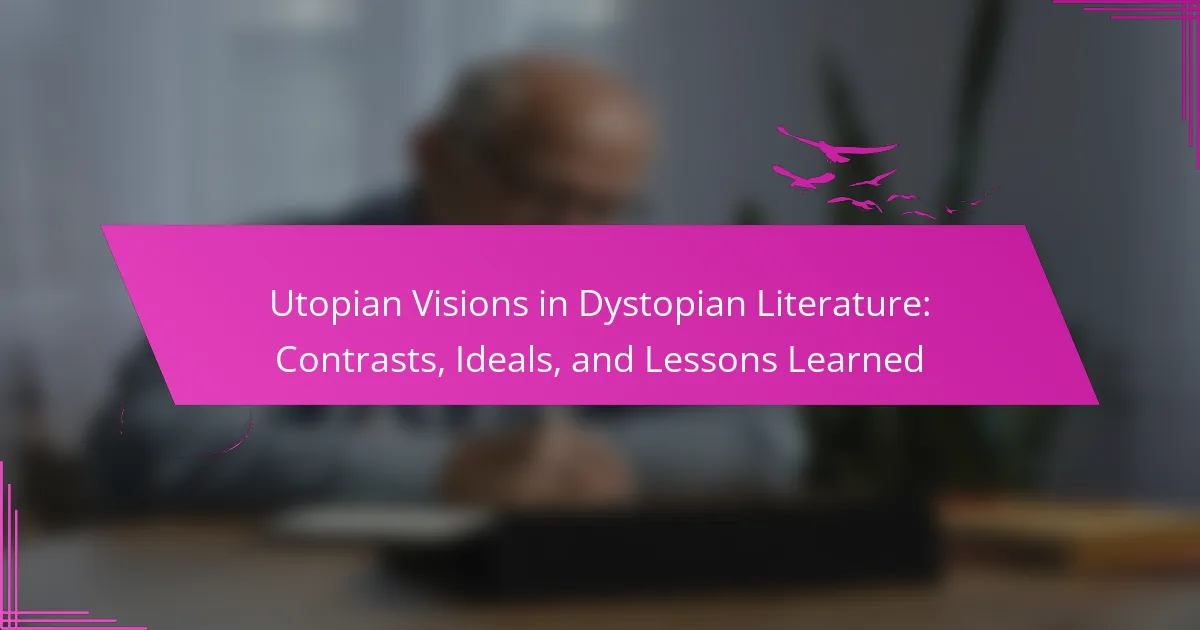Dystopian literature often reveals the fragility of utopian visions, highlighting the dangers of idealism and authoritarian control. This article examines contrasts between utopia and dystopia, explores character development shaped by these ideals, and identifies rare attributes that enrich the narrative. By analyzing these themes, readers can gain insights into societal critiques and the complexities of human nature.
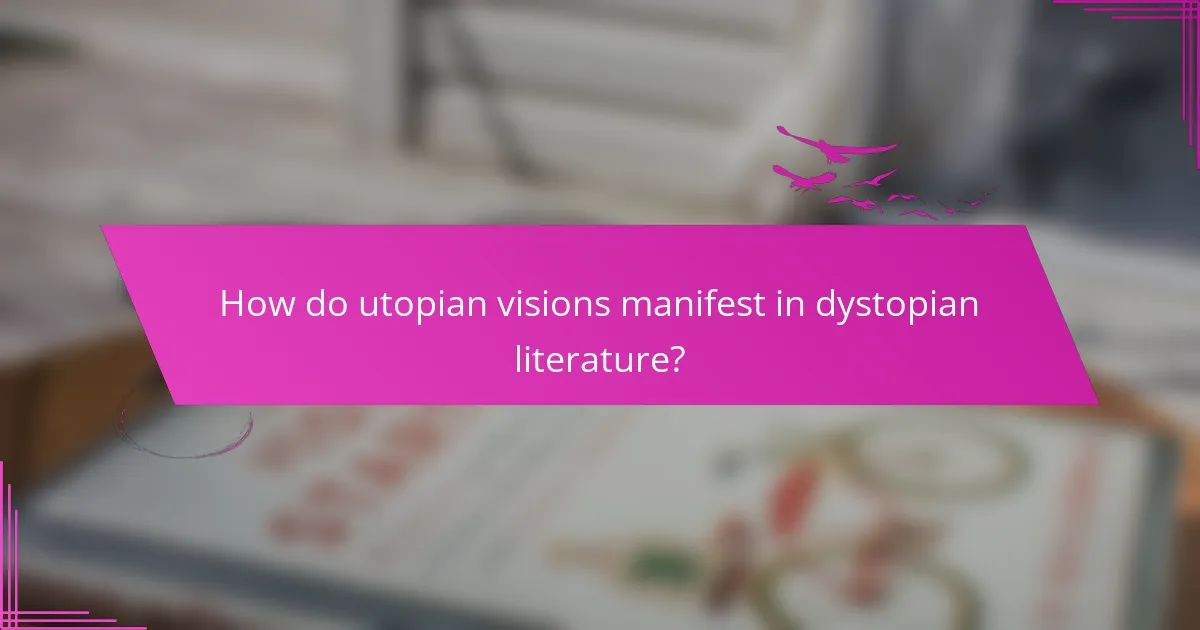
How do utopian visions manifest in dystopian literature?
Utopian visions manifest in dystopian literature as cautionary tales that highlight the flaws in idealism. These narratives often juxtapose a perfect society against the grim realities of authoritarian control, revealing the dangers of absolute power. For instance, in George Orwell’s “1984,” the initial utopian promise of a collective society devolves into oppression. Such contrasts emphasize the importance of individual freedoms and the potential consequences of sacrificing them for a perceived greater good. Ultimately, these works serve as critical reflections on societal ideals, urging readers to consider the balance between utopia and dystopia.
What are the key characteristics of utopian ideals in literary contexts?
Utopian ideals in literary contexts often emphasize harmony, equality, and social justice. These characteristics contrast sharply with the dystopian settings that highlight societal flaws. Utopian visions serve as a critique of current realities, revealing aspirations for a better world. They encourage readers to envision possibilities beyond oppressive systems.
Which literary works prominently feature contrasting utopian visions?
Several literary works showcase contrasting utopian visions, highlighting different ideals and societal critiques. Notable examples include “Utopia” by Thomas More, which presents an idealized society, and “Brave New World” by Aldous Huxley, depicting a dystopian reality masked as utopia. “1984” by George Orwell illustrates a totalitarian regime, contrasting with the hopeful vision in “The Dispossessed” by Ursula K. Le Guin, which explores anarchist ideals. These works collectively offer insights into human aspirations and the potential pitfalls of utopian thinking.
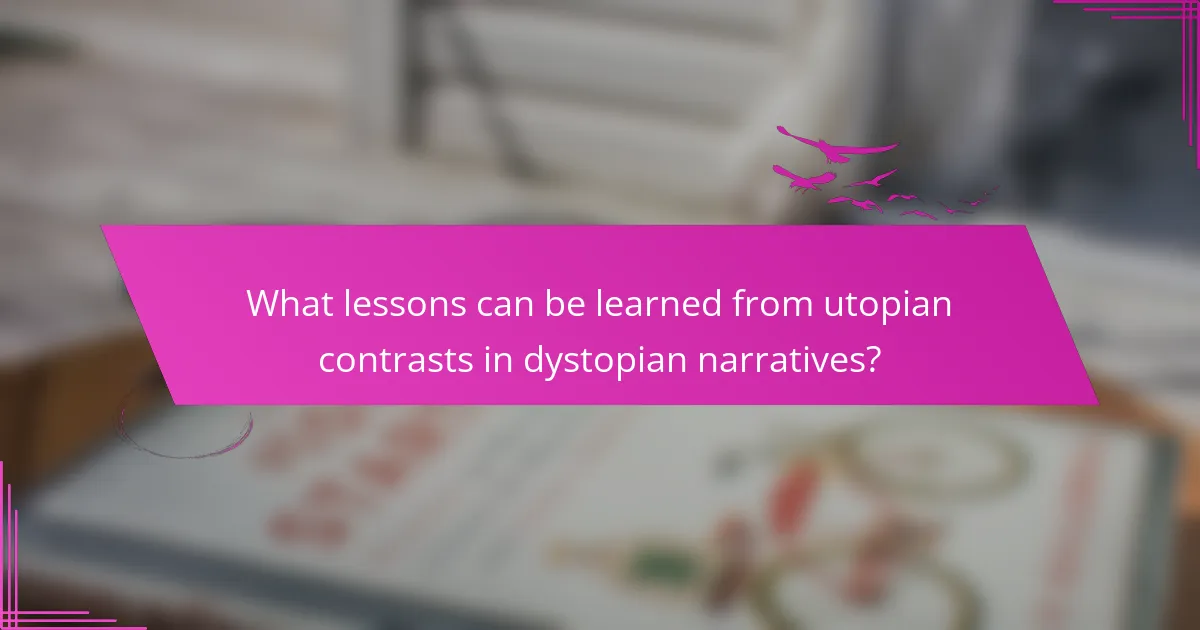
What lessons can be learned from utopian contrasts in dystopian narratives?
Utopian contrasts in dystopian narratives teach valuable lessons about societal ideals and human nature. These narratives often highlight the fragility of utopian visions when faced with oppressive systems. They illustrate how idealism can lead to disillusionment, showing the importance of balance between aspiration and realism. Additionally, such contrasts provoke critical thinking about current societal structures, encouraging readers to reflect on their values and the potential consequences of unchecked power. Ultimately, these stories serve as cautionary tales that inspire a more thoughtful pursuit of a better future.
How do these lessons apply to contemporary societal issues?
Utopian visions in dystopian literature highlight contrasts that resonate with contemporary societal issues. These narratives often reflect ideals that challenge current norms, prompting critical examination of governance, technology, and social justice. For instance, themes of surveillance in dystopian works mirror modern concerns about privacy and data security. Lessons learned from these contrasts encourage proactive engagement with societal structures, fostering awareness and advocacy for equitable solutions. By analyzing these literary examples, society can better navigate the complexities of modern challenges.
What role does hope play in dystopian literature’s portrayal of utopia?
Hope serves as a crucial element in dystopian literature, highlighting the contrast between oppressive realities and idealistic visions of utopia. It often motivates characters to strive for a better future, emphasizing resilience amid despair. This interplay reveals that even in bleak circumstances, the aspiration for a utopian existence can inspire change and challenge authoritarian structures. Authors use hope to critique societal flaws, suggesting that the pursuit of utopia, despite its challenges, remains essential for human spirit and progress.
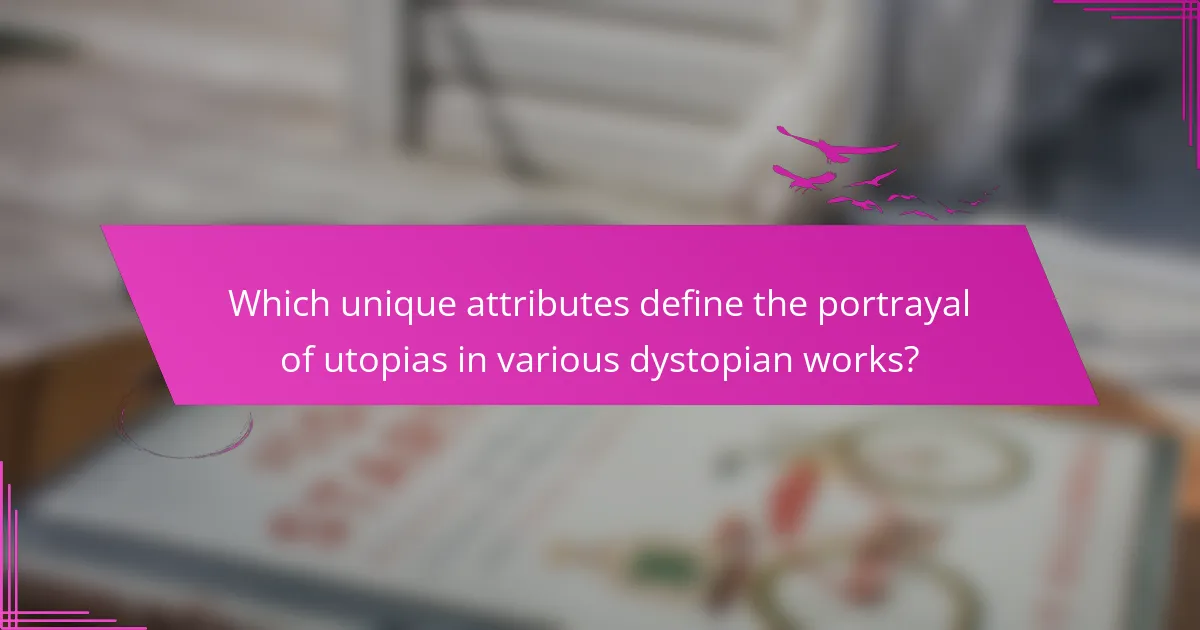
Which unique attributes define the portrayal of utopias in various dystopian works?
Unique attributes defining utopias in dystopian works include idealism, societal structure, and moral dilemmas. Idealism often contrasts with the harsh realities presented in dystopian narratives. Societal structure reflects the organization of communities, showcasing both harmony and conflict. Moral dilemmas highlight the ethical challenges faced in pursuing utopian ideals. These attributes reveal lessons about human nature and societal aspirations.
How do cultural perspectives influence utopian depictions in dystopian literature?
Cultural perspectives significantly shape utopian depictions in dystopian literature by reflecting societal values and aspirations. These narratives often contrast ideal societies with their flawed realities, revealing insights about human nature and governance. For example, works like Aldous Huxley’s “Brave New World” critique consumerism while presenting a vision of superficial happiness. Similarly, George Orwell’s “1984” explores totalitarianism, showcasing how cultural fears influence utopian ideals. This interplay allows authors to critique contemporary issues, illustrating the lessons learned from both utopian dreams and dystopian failures.
What are some notable examples of regional variations in utopian themes?
Notable examples of regional variations in utopian themes include distinct cultural interpretations. In Scandinavian literature, the emphasis is on egalitarianism and environmental sustainability, reflecting social welfare ideals. Conversely, Latin American works often explore communal living and indigenous philosophies, showcasing the importance of community ties. In contrast, American dystopian narratives frequently critique capitalism and individualism, presenting a cautionary view of technological advancement. These variations highlight how local values and historical contexts shape utopian visions, offering diverse lessons learned from each perspective.
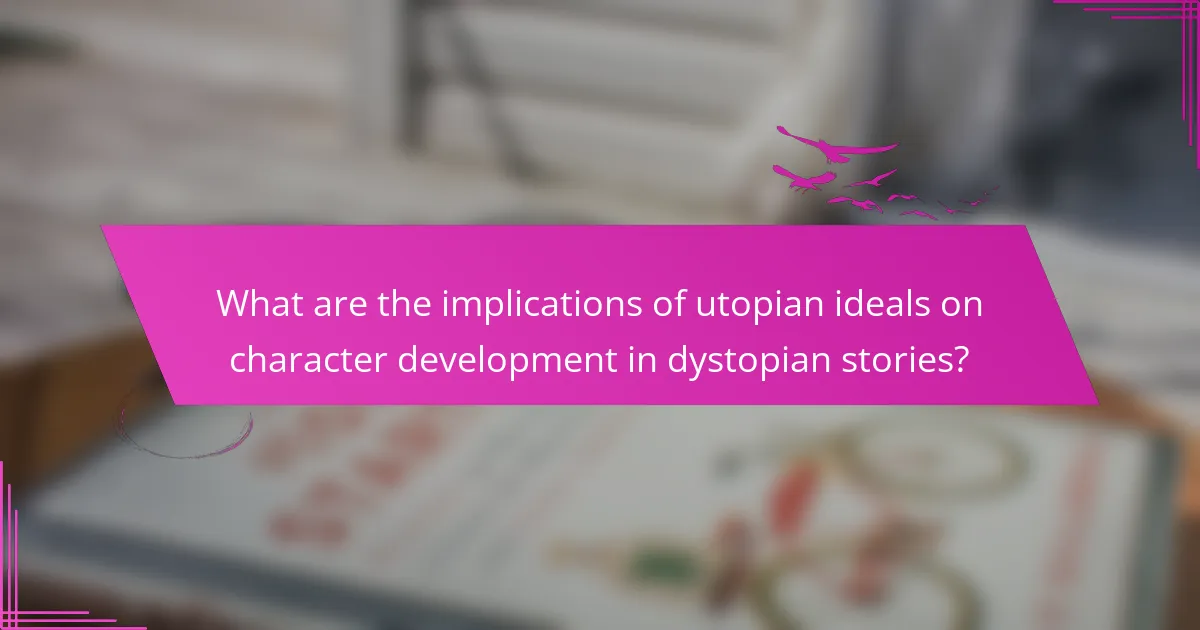
What are the implications of utopian ideals on character development in dystopian stories?
Utopian ideals profoundly influence character development in dystopian stories by contrasting aspirations with harsh realities. Characters often embody the struggle between idealism and the oppressive environments they inhabit. This tension highlights their growth, resilience, or moral decline. For example, protagonists may initially pursue utopian goals but confront disillusionment, leading to complex transformations. Such narratives reflect the consequences of unattainable ideals, emphasizing the need for realistic approaches to societal issues. Ultimately, these character arcs serve as cautionary tales about the dangers of extreme utopian visions.
How do characters embody or challenge utopian visions?
Characters in dystopian literature often embody or challenge utopian visions by illustrating the consequences of idealism. They reflect human desires for a perfect society while exposing flaws in such aspirations. For example, protagonists may strive for a utopian ideal but face oppressive systems that highlight the gap between dreams and reality. This tension reveals the complexities of human nature and societal structures. As a result, characters serve as vehicles for exploring the lessons learned from failed utopias, emphasizing the importance of critical reflection on ideals.
What is the impact of character choices on the narrative’s exploration of utopia?
Character choices significantly influence the narrative’s exploration of utopia by highlighting the contrast between ideals and reality. These choices often reflect the complexities of human nature, revealing how personal motivations can shape societal structures. For instance, characters who embody utopian ideals may struggle against oppressive systems, illustrating the tension between individual freedom and collective harmony. This dynamic encourages readers to question the feasibility of utopian visions and consider the lessons learned from dystopian outcomes. Ultimately, character decisions serve as a lens through which the narrative critiques or reinforces the concept of utopia.

Which rare attributes of dystopian literature enhance the exploration of utopia?
Rare attributes of dystopian literature, such as irony, paradox, and moral ambiguity, enhance the exploration of utopia by highlighting the fragility of ideal societies. Irony often reveals the gap between utopian ideals and dystopian realities, prompting critical reflection. Paradox challenges readers to question the feasibility of utopian visions, illustrating the complexities of human nature. Moral ambiguity invites deeper ethical considerations, allowing for nuanced discussions on the implications of striving for perfection. These attributes collectively enrich the narrative, making the exploration of utopia more profound and thought-provoking.
How do unconventional narrative structures influence the depiction of utopian themes?
Unconventional narrative structures enhance the depiction of utopian themes by challenging traditional storytelling. These structures, such as fragmented timelines or multiple perspectives, encourage readers to engage actively with the text. This engagement allows for a deeper exploration of ideals and contrasts present within utopian visions. For instance, non-linear narratives can juxtapose dystopian realities with utopian aspirations, revealing the complexities of societal ideals. This method not only highlights the root attributes of utopian literature but also emphasizes unique aspects of individual characters’ journeys, making the themes more relatable and impactful.
What is the significance of allegory in conveying utopian visions?
Allegory significantly enhances the portrayal of utopian visions by illustrating ideals through symbolic narratives. This technique allows authors to critique societal flaws while presenting aspirational concepts. Allegorical elements create relatable scenarios, enabling readers to engage with complex ideas. For example, George Orwell’s “Animal Farm” uses animal characters to reflect on political systems, highlighting the disparity between utopian aspirations and dystopian realities. This contrast serves as a powerful lesson in the potential pitfalls of idealism.
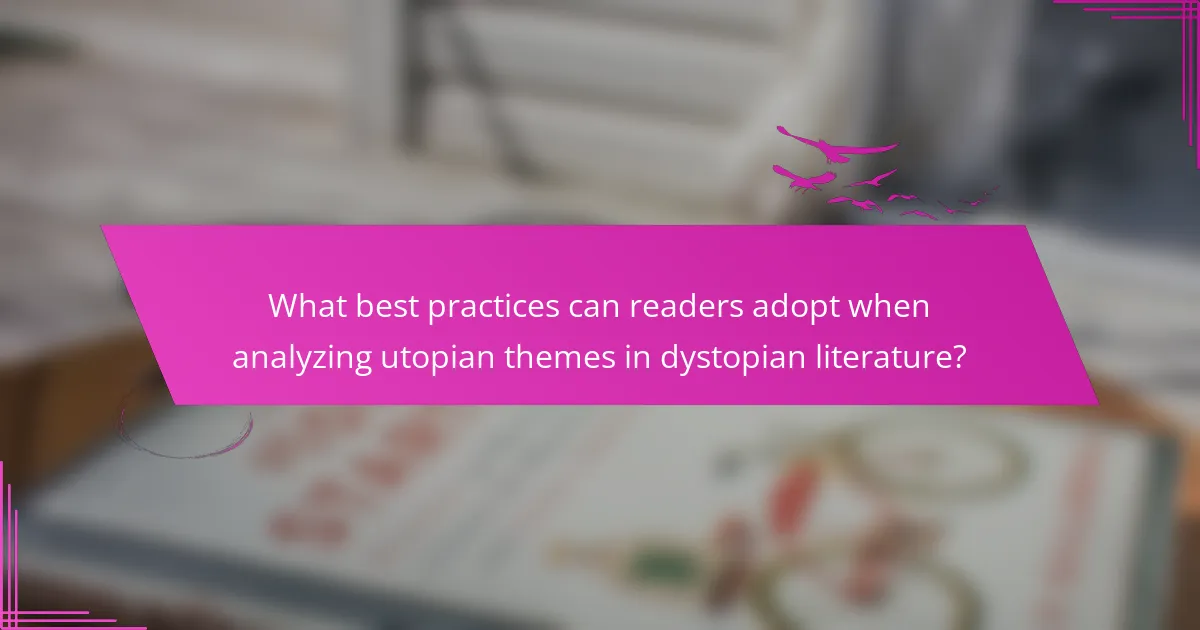
What best practices can readers adopt when analyzing utopian themes in dystopian literature?
Readers can adopt several best practices when analyzing utopian themes in dystopian literature. First, identify contrasting ideals by examining how utopian visions reflect societal critiques. Analyze character motivations to understand the pursuit of these ideals. Consider the narrative structure, as it often reveals underlying lessons about human nature and societal organization. Explore the consequences of utopian aspirations within dystopian settings to uncover deeper meanings. Lastly, engage with diverse interpretations to enrich the analysis and foster critical thinking.
How can critical thinking enhance the understanding of contrasting ideals?
Critical thinking enhances understanding of contrasting ideals by encouraging analysis and evaluation of different perspectives. It allows readers to dissect utopian and dystopian elements in literature, revealing underlying themes and societal critiques. Through critical thinking, individuals can better appreciate the complexities of human nature and the implications of idealism versus realism. This deeper comprehension fosters informed discussions about moral dilemmas and potential futures depicted in such narratives. Ultimately, critical thinking serves as a tool for recognizing the value and limitations of contrasting ideals within the broader context of societal evolution.
What common mistakes should be avoided in interpreting utopian narratives?
To effectively interpret utopian narratives, avoid oversimplifying their complexities. Misinterpretations often stem from neglecting the nuances that differentiate utopian ideals from dystopian realities.
Common mistakes include failing to recognize the context of the narrative, overlooking the author’s intent, and assuming a singular interpretation. Additionally, ignoring the interplay between utopia and dystopia can lead to a skewed understanding of the lessons presented.
Engaging critically with these narratives enhances comprehension and fosters deeper insights into societal values and aspirations.
